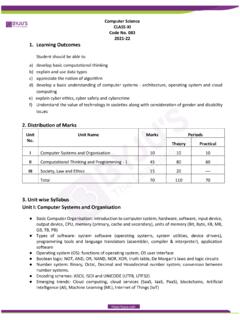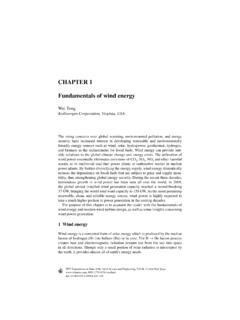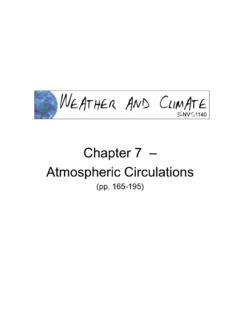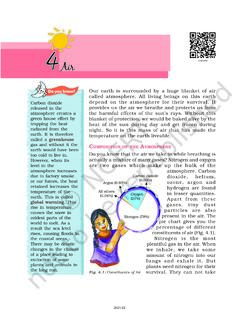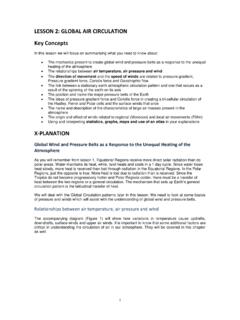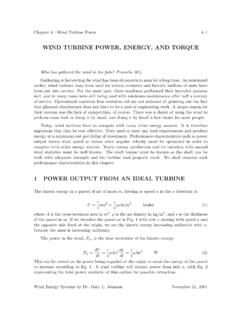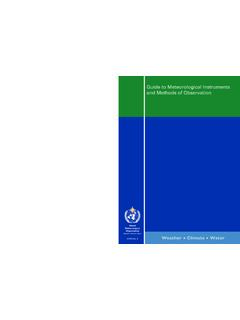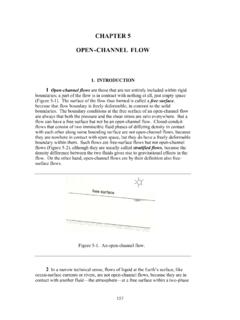Transcription of NCERT Book for Class 9 Geography Chapter 4
1 In the last two chapters you have read aboutthe landforms and the drainage ofour country. These are the two of the threebasic elements that one learns about the naturalenvironment of any area. In this Chapter youwill learn about the third, that is, theatmospheric conditions that prevail over ourcountry. Why do we wear woollens in Decemberor why it is hot and uncomfortable in the monthof May, and why it rains in June - July? Theanswers to all these questions can be found outby studying about the climate of refers to the sum total of weatherconditions and variations over a large area fora long period of time (more than thirty years).Weather refers to the state of the atmosphereover an area at any point of time. The elementsof weather and climate are the same, , atmospheric pressure , wind ,humidity and precipitation.
2 You may haveobserved that the weather conditions fluctuatevery often even within a day. But there is somecommon pattern over a few weeks or months, days are cool or hot, windy or calm, cloudyor bright, and wet or dry. On the basis of thegeneralised monthly atmospheric conditions,the year is divided into seasons such as winter,summer or rainy world is divided into a number ofclimatic regions. Do you know what type ofclimate India has and why it is so? We willlearn about it in this Chapter . The word monsoon isderived from the Arabic word mausim whichliterally means season. Monsoon refers to the seasonal reversal in thewind direction during a climate of India is described as the monsoon type. In Asia, this type of climateis found mainly in the south and the an overall unity in the general pattern,there are perceptible regional variations inclimatic conditions within the country.
3 Let ustake two important elements temperature andprecipitation, and examine how they vary fromplace to place and season to summer, the mercury occasionallytouches 50 C in some parts of the Rajasthandesert, whereas it may be around 20 C inPahalgam in Jammu and Kashmir. On a winternight, temperature at Drass in Jammu andKashmir may be as low as minus 45 , on the other hand, mayhave a temperature of 22 certain places there is awide difference between day and nighttemperatures. In the Thar Desert the daytemperature may rise to 50 C, and drop downto near 15 C the same night. On the other hand,there is hardly any difference in day and nighttemperatures in the Andaman and Nicobarislands or in us now look at precipitation. There arevariations not only in the form and types ofprecipitation but also in its amount and theseasonal distribution.
4 While precipitation ismostly in the form of snowfall in the upper partsof Himalayas, it rains over the rest of thecountry. The annual precipitation varies fromover 400 cm in Meghalaya to less than 10 cmin Ladakh and western Rajasthan. Most partsof the country receive rainfall from June toSeptember. But some parts like the Tamil Nadu42019-20 CLIMATE27 Why most of the world s deserts arelocated in the western margins of continents in thesubtropics?Finally, relief too plays a major role indetermining the climate of a place. High mountainsact as barriers for cold or hot winds; they mayalso cause precipitation if they are high enoughand lie in the path of rain-bearing winds. Theleeward side of mountains remains relatively AFFECTING INDIA S CLIMATEL atitudeThe Tropic of Cancer passes through the middleof the country from the Rann of Kuchchh in thewest to Mizoram in the east.
5 Almost half of thecountry, lying south of the Tropic of Cancer,belongs to the tropical area. All the remainingarea, north of the Tropic, lies in the , India s climate has characteristics oftropical as well as subtropical has mountains to the north, which havean average height of about 6,000 metres. Indiaalso has a vast coastal area where themaximum elevation is about 30 metres. TheHimalayas prevent the cold winds from CentralAsia from entering the subcontinent. It isbecause of these mountains that thissubcontinent experiences comparativelymilder winters as compared to central and WindsThe climate and associated weather conditionsin India are governed by the followingatmospheric conditions: pressure and surface winds; Upper air circulation; and Western cyclonic disturbances andtropical lies in the region of north easterlywinds.
6 These winds originate from thesubtropical high- pressure belt of the northerncoast gets a large portion of its rain duringOctober and November. In general, coastal areas experience lesscontrasts in temperature conditions. Seasonalcontrasts are more in the interior of thecountry. There is decrease in rainfall generallyfrom east to west in the Northern Plains. Thesevariations have given rise to variety in lives ofpeople in terms of the food they eat, theclothes they wear and also the kind of housesthey live in. Why the houses in Rajasthan have thickwalls and flat roofs? Why is it that the houses in the Tarai region andin Goa and Mangalore have sloping roofs? Why houses in Assam are built on stilts?CLIMATIC CONTROLST here are six major controls of the climate ofany place.
7 They are: latitude, altitude, pressure and wind system, distance fromthe sea (continentality), ocean currents andrelief to the curvature of the earth, theamount of solar energy received variesaccording to latitude. As a result, airtemperature generally decreases from theequator towards the poles. As one goes fromthe surface of the earth to higher altitudes,the atmosphere becomes less dense andtemperature decreases. The hills are thereforecooler during summers. The pressure andwind system of any area depend on thelatitude and altitude of the place. Thus itinfluences the temperature and rainfallpattern. The sea exerts a moderating influenceon climate: As the distance from the seaincreases, its moderating influence decreasesand the people experience extreme weatherconditions.
8 This condition is known ascontinentality ( very hot during summersand very cold during winters). Ocean currentsalong with onshore winds affect the climate ofthe coastal areas, For example, any coastalarea with warm or cold currents flowing pastit, will be warmed or cooled if the winds INDIA-Ihemisphere. They blow southwards, getdeflected to the right due to the Coriolis force,and move towards the equatorial low-pressurearea. Generally, these winds carry littlemoisture as they originate and blow over , they bring little or no rain. Hence,India should have been an arid land, but it isnot so. Let us see why?Coriolis force: An apparent force caused by the earth srotation. The Coriolis force is responsible for deflectingwinds towards the right in the northern hemisphereand towards the left in the southern hemisphere.
9 Thisis also known as Ferrel s Law .The pressure and wind conditions overIndia are unique. During winter, there is ahigh- pressure area north of the dry winds blow from this region to thelow- pressure areas over the oceans to thesouth. In summer, a low- pressure areadevelops over interior Asia, as well as, overnorthwestern India. This causes a completereversal of the direction of winds duringsummer. Air moves from the high-pressurearea over the southern Indian Ocean, in asouth-easterly direction, crosses the equator,and turns right towards the low- pressure areasover the Indian subcontinent. These are knownas the Southwest Monsoon winds. These windsblow over the warm oceans, gather moistureand bring widespread rainfall over themainland of upper air circulation in this region isdominated by a westerly flow.
10 An importantcomponent of this flow is the jet jet streams are located approximatelyover 27 -30 north latitude, therefore, they areknown as subtropical westerly jet streams. OverIndia, these jet streams blow south of theHimalayas, all through the year except insummer. The western cyclonic disturbancesexperienced in the north and north-western partsof the country are brought in by this westerlyflow. In summer, the subtropical westerly jetstream moves north of the Himalayas with theapparent movement of the sun. An easterly jetstream, called the sub-tropical easterly jet streamblows over peninsular India, approximately over14 N during the summer Cyclonic DisturbancesThe western cyclonic disturbances are weatherphenomena of the winter months brought in by thewesterly flow from the Mediterranean region.




